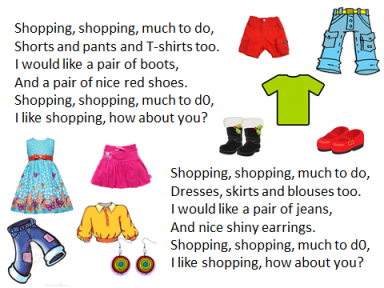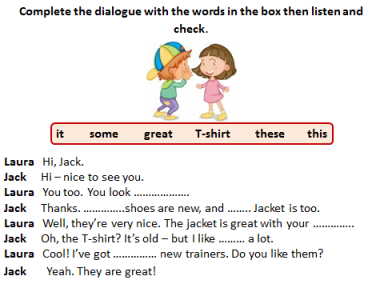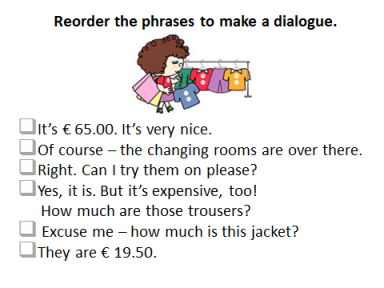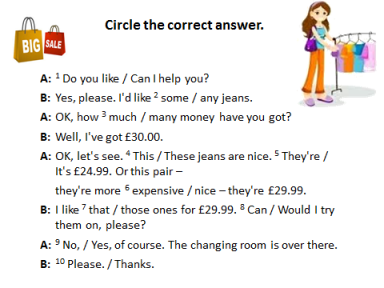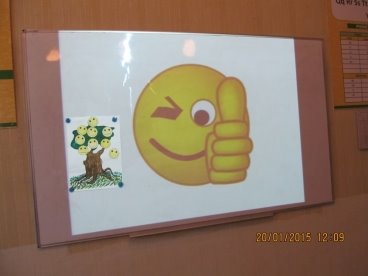Урок "Shopping For Clothes"
- Exercise.docx docx
- Exercises.doc doc
- Shopping for clothes.pptx pptx
- звіт.docx docx
- Показати всі файли
|
Complete the dialogue with the words in the box, then listen and check.
Laura Hi, Jack. Jack Hi – nice to see you. Laura You too. You look ………………. Jack Thanks. …………..shoes are new, and …….. Jacket is too. Laura Well, they’re very nice. The jacket is great with your ………….. Jack Oh, the T-shirt? It’s old – but I like ……… a lot. Laura Cool! I’ve got …………… new trainers. Do you like them? Jack Yeah. They are great!
|
|
Complete the dialogue with the words in the box, then listen and check.
Laura Hi, Jack. Jack Hi – nice to see you. Laura You too. You look ………………. Jack Thanks. …………..shoes are new, and …….. Jacket is too. Laura Well, they’re very nice. The jacket is great with your ………….. Jack Oh, the T-shirt? It’s old – but I like ……… a lot. Laura Cool! I’ve got …………… new trainers. Do you like them? Jack Yeah. They are great!
|
|
Complete the dialogue with the words in the box, then listen and check.
Laura Hi, Jack. Jack Hi – nice to see you. Laura You too. You look ………………. Jack Thanks. …………..shoes are new, and …….. Jacket is too. Laura Well, they’re very nice. The jacket is great with your ………….. Jack Oh, the T-shirt? It’s old – but I like ……… a lot. Laura Cool! I’ve got …………… new trainers. Do you like them? Jack Yeah. They are great!
|
|
Reorder the phrases to make a dialogue. Then read it in pairs.
How much are those trousers?
|
Reorder the phrases to make a dialogue. Then read it in pairs.
How much are those trousers?
|
|
Reorder the phrases to make a dialogue. Then read it in pairs.
How much are those trousers?
|
Reorder the phrases to make a dialogue. Then read it in pairs.
How much are those trousers?
|
|
Reorder the phrases to make a dialogue. Then read it in pairs.
How much are those trousers?
|
Reorder the phrases to make a dialogue. Then read it in pairs.
How much are those trousers?
|
|
Reorder the phrases to make a dialogue. Then read it in pairs.
How much are those trousers?
|
Reorder the phrases to make a dialogue. Then read it in pairs.
How much are those trousers?
|
1. Complete the dialogue with the words in the box, then listen and check.
Laura Hi, Jack.
Jack Hi – nice to see you.
Laura You too. You look ……………….
Jack Thanks. …………..shoes are new, and …….. Jacket is too.
Laura Well, they’re very nice. The jacket is great with your …………..
Jack Oh, the T-shirt? It’s old – but I like ……… a lot.
Laura Cool! I’ve got …………… new trainers. Do you like them?
Jack Yeah. They are great!
- Reorder the phrases to make a dialogue. Then read it in pairs.
- It’s € 65.00. It’s very nice.
- Of course – the changing rooms are over there.
- Right. Can I try them on please?
- Yes, it is. But it’s expensive, too! How much are those trousers?
- Excuse me – how much is this jacket?
- They are € 19.50.
- Circle the correct answer.
A: Do you like / Can I help you?
B: Yes, please. I'd like some / any jeans.
A: OK, how much / many money have you got?
B: Well, I've got £30.00.
A: OK, let's see. This / These jeans are nice. They're / It's £24.99. Or this pair –
they're more expensive / nice – they're £29.99.
B: I like that / those ones for £29.99. Can / Would I try them on, please?
A: No, / Yes, of course. The changing room is over there.
B: Please. / Thanks.
4. Reorder the letters. Write the names of the clothes.
1. serds ________________________ 4. hoess ________________________
2. rearnits ______________________ 5. nsjea ______________________
3. tah ________________________
5. Read the text and circle T (True) or F (False). |
|||
|
|
|
|
|
Anita Randon lives in Boston, USA. She lives in a big house with her parents, Maryanne and Garry. Her grandparents live with her. Their names are Elsie and Stan, they're both eighty-two.
|
|||
|
|
|
T |
F |
1. |
There are five people in Anita's house. |
|
|
2. |
Anita's bedroom is blue. |
|
|
3. |
Anita likes lots of different colours. |
|
|
4. |
All Anita's friends can rollerblade. |
|
|
5. |
Anita's friends like playing computer games. |
|
|
Відкритий урок у 5 класі з теми
Shopping for Clothes
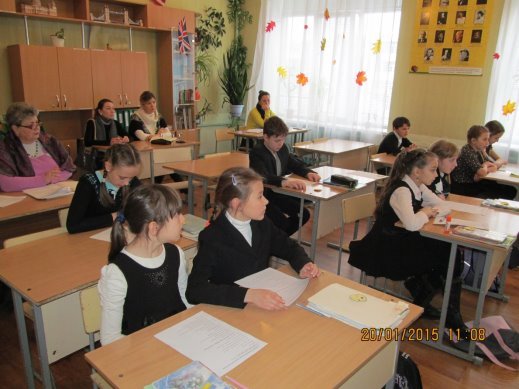
На уроці
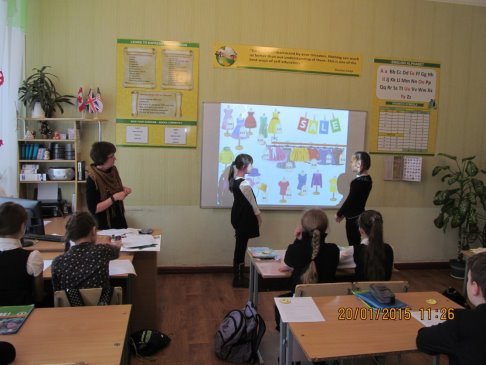
Учні «купують» одяг у віртуальному магазині
|
Повідомлення теми та мети уроку |
|
|
|
|
|
Учні разом з учителем співають пісню “Shopping Song” |
|
|
|
|
|
Уведення в іншомовну атмосферу (Warming-up) Учитель ознайомлює учнів із ідіомою “have ants in your pants”. Після пояснення, що таке ідіома, та наведення прикладів, учитель пропонує учням знайти російський еквівалент ідіоми “have ants in your pants” (быть как на иголках). |
|
|
|
|
|
|
|
|
|
|
|
Учні вставляють у діалог пропущені слова, слухають запис та перевіряють правильність виконання завдання. Далі учні читають діалог у парах. |
|
|
|
|
|
Розвиток навичок діалогічного мовлення Завдання 1 - Jumbled dialogues Учні отримують картки з діалогами, у яких репліки перемішані. Спочатку учні розставляють репліки в правильному порядку, потім читають діалоги в парах. |
|
|
|
|
|
Розвиток навичок діалогічного мовлення Завдання 1 Завдання 2 - Multiple choice Учні мають вибрати правильні слова у діалозі та підкреслити їх. Далі учні читають діалоги в парах. |
|
|
|
|
|
|
|
|
|
|
|
|
|
|
Учні по двоє ідуть до віртуального магазину, обирають та купують собі одяг.
(Віідід одягу для дівчат) |
|
|
|
|
|
Відділ одягу для хлопців |
|
|
|
|
|
Рефлексія Учні отримують «смайлики». Учитель пропонує учням за допомогою «смайликів» розказати про свої почуття наприкінці уроку. |
|
КУ Сумська загальноосвітня школа І-ІІІ ступенів №18 м. Суми, Сумської області



Тема уроку: Shop Till You Drop
Навчальна мета: Тренувати учнів у вживанні лексичних одиниць з теми «Shopping For Clothes”. Практикувати учнів в аудіюванні, читанні та діалогічному мовленні.
Дидактична мета: Розвивати мовну здогадку. Розвивати фонетичний слух. Сприяти розвитку самостійного мислення учнів.
Виховна мета: Виховувати культуру спілкування
Обладнання: Підручник, роздавальний матеріал, комп’ютер, проектор, презентація PowerPoint, малюнок дерева, смайлики
Хід уроку
- Підготовка до сприйняття іншомовного мовлення.
- Повідомлення теми та мети уроку
T: You see that the theme of our lesson is “Shop Till You Drop”. During the lesson we are going to learn how to buy clothes and then we’ll go to our virtual store and do our shopping till you are so tired that you drop.ЩщЩ
2.Уведення в іншомовну атмосферу (Warming-up)
- Учні разом з учителем співають пісню “Shopping Song”.
- Учитель ознайомлює учнів із ідіомою “have ants in your pants”. Після пояснення, що таке ідіома, та наведення прикладів, учитель пропонує учням знайти російський еквівалент ідіоми “have ants in your pants” (быть как на иголках).
- Основна частина уроку
- Аудіювання
Учні прослуховують діалоги та виконують завдання
- Розвиток навичок діалогічного мовлення (Worksheets)
- Завдання 1 (ex.2). Jumbled dialogues
Учні отримують картки з діалогами, у яких репліки перемішані. Спочатку учні розставляють репліки в правильному порядку, потім читають діалоги в парах.
- Завдання 2 (ex.3). Multiple choice
Учні мають вибрати правильні слова у діалозі та підкреслити їх. Далі учні читають діалоги в парах.
- Фізкультхвилинка (Head, Shoulders, Knees ant Toes)
- Розвиток навичок діалогічного мовлення
Учні прослуховують діалог (впр.10 с.84) і читають його в парах.
- Рольова гра “Buying Clothes”
Учні у парах ідуть до віртуального магазину (слайди презентації), обирають та купують собі одяг.
- Резервне завдання 1. Розвиток граматичних навичок
Виконання вправи 9 на с.84
- Резервне завдання 2. (Worksheet – ex.1). Учні вставляють у діалог пропущені слова, слухають запис та перевіряють правильність виконання завдання. Далі учні читають діалог у парах.
- Заключна частина уроку
- Домашнє завдання
T: At home do exercises 1, 4 and 5 on your worksheets.
- Підведення підсумків уроку
T: What have you learned at the lesson today?
Did you enjoy the song?
Did you like the role-play?
Which activities did you like best?
- Оцінювання учнів
T: You worked very well today, your mark is ….
And you…. , were not active enough, so your mark is ….
- Рефлексія
Учні отримують «смайлики». Учитель пропонує учням за допомогою «смайликів» розказати про свої почуття наприкінці уроку.
это свойственное только данному языку устойчивое сочетание слов, значение которого не определяется значением входящих в него слов, взятых по отдельности. Из-за того, что фразеологизм (или же идиому) невозможно перевести дословно (теряется смысл) часто возникают трудности перевода и понимания.


про публікацію авторської розробки
Додати розробку
























